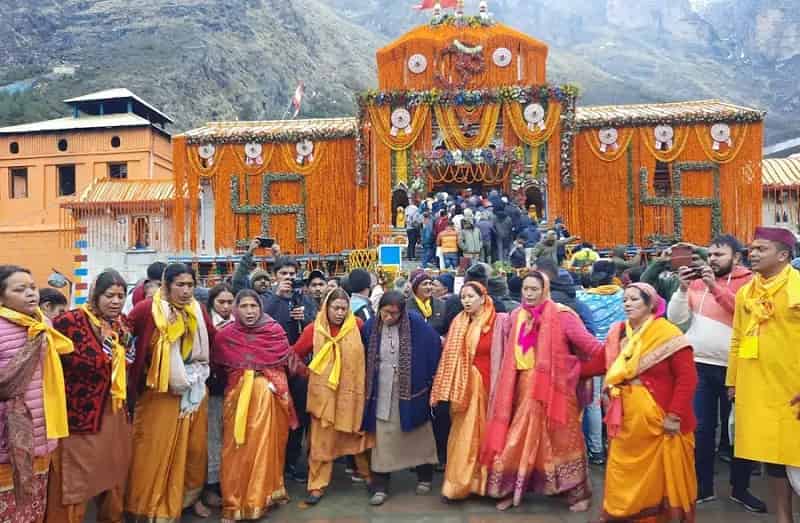The Badrinath Temple, nestled in the picturesque Chamoli district of Uttarakhand, India, is a testament to the rich tapestry of Hindu mythology and spirituality. With its towering spires, intricate carvings, and serene surroundings, this sacred shrine has stood as a beacon of devotion for countless devotees for centuries. Embark on a fascinating journey as we delve into the intriguing Badrinath Temple history, uncovering its origins, legends, and the spiritual allure that draws pilgrims from far and wide.
Table of Contents
Badrinath Temple History: A Tapestry of Legends

The Divine Connection: Mythology and Origins
The origins of Badrinath Temple can be traced back to ancient Hindu mythology. According to legends, the temple is dedicated to Lord Badrinath, an incarnation of Lord Vishnu—the preserver and protector of the universe. It is believed that Lord Vishnu once meditated in the region, assuming the form of the mystic sage, Nar-Narayan. The temple was later established at the same spot to commemorate this divine event.
- Also Read: Badrinath Yatra Road Route Map
Ancient Foundations: Tracing the Roots
The historical records of Badrinath Temple date back to the 9th century CE, during the reign of the Katyuri dynasty. However, archaeological excavations and inscriptions discovered in the vicinity suggest that the temple’s roots may extend even further into antiquity. The temple’s architecture reflects a blend of different styles, with influences from the Garhwal and Kumaon regions, showcasing the artistic finesse of the craftsmen of yore.
An Enduring Legacy: Renovations and Restorations
Over the centuries, the Badrinath Temple has undergone numerous renovations and restorations, ensuring its preservation and grandeur. Rulers from different dynasties, including the Gupta, Katyuri, and Chand dynasty, have contributed to the temple’s expansion and beautification. The current structure, dating back to the 16th century, was established by the Garhwal kings, who further enhanced the temple complex.
Unveiling the Spiritual Significance
A Journey of Redemption: The Char Dham Yatra
Badrinath Temple holds immense significance as one of the four sacred sites of the Char Dham Yatra, a revered pilgrimage circuit in Hinduism. The temple is situated in the lap of the majestic Himalayas, offering pilgrims a transformative spiritual experience. The Yatra, encompassing Badrinath, along with Yamunotri, Gangotri, and Kedarnath, symbolizes the pursuit of moksha (liberation) and divine blessings.
Rituals and Offerings: Seeking Divine Grace
Every year, the Badrinath Temple opens its gates to devotees after a six-month winter closure. The temple rituals, performed by the Rawal (head priest), follow a strict schedule. The day begins with the Mangala Aarti, an early morning ceremony where prayers and hymns are sung to awaken the deity. The temple also hosts various rituals like Abhishekam (sacred bath), Panchamrit Snan (bathing with holy water), and Bhog (offering of food) to seek the blessings of Lord Badrinath.
FAQs about Badrinath Temple History
1. When was the Badrinath Temple built?
The Badrinath Temple was constructed in the 9th century CE, but its origins can be traced back even further, possibly to ancient times.
2. What is the significance of the Badrinath Temple in Hinduism?
The Badrinath Temple holds great significance in Hinduism as one of the Char Dham pilgrimage sites. It is believed that visiting this sacred shrine brings spiritual redemption and blessings.
3. Are there any legends associated with the Badrinath Temple?
Yes, according to Hindu mythology, Lord Vishnu meditated in the region in the form of Nar-Narayan. The temple was established to commemorate this divine event.
4. Who is the presiding deity of the Badrinath Temple?
The Badrinath Temple is dedicated to Lord Badrinath, an incarnation of Lord Vishnu.
5. What are the rituals performed at the Badrinath Temple?
The temple hosts various rituals, including the Mangala Aarti, Abhishekam, Panchamrit Snan, and Bhog, to seek the blessings of Lord Badrinath.
6. How is the Badrinath Temple associated with the Char Dham Yatra?
The Badrinath Temple is one of the four sacred sites of the Char Dham Yatra. Pilgrims embark on this journey to attain spiritual liberation and divine grace.
Conclusion: A Sanctuary of Devotion and Faith
The Badrinath Temple stands as a testament to the enduring devotion and faith of millions of devotees who have made the pilgrimage to this sacred shrine over the centuries. Its ancient origins, rich mythology, and spiritual significance make it a treasured landmark in the religious and cultural fabric of India. As pilgrims flock to the temple, they are greeted by its awe-inspiring architecture, serene surroundings, and a profound sense of tranquility that envelops the air. The Badrinath Temple history continues to unfold, captivating the hearts of those who seek solace, redemption, and the divine blessings bestowed by Lord Badrinath.
- Suggested Tour: Badrinath Yatra Tour Packages